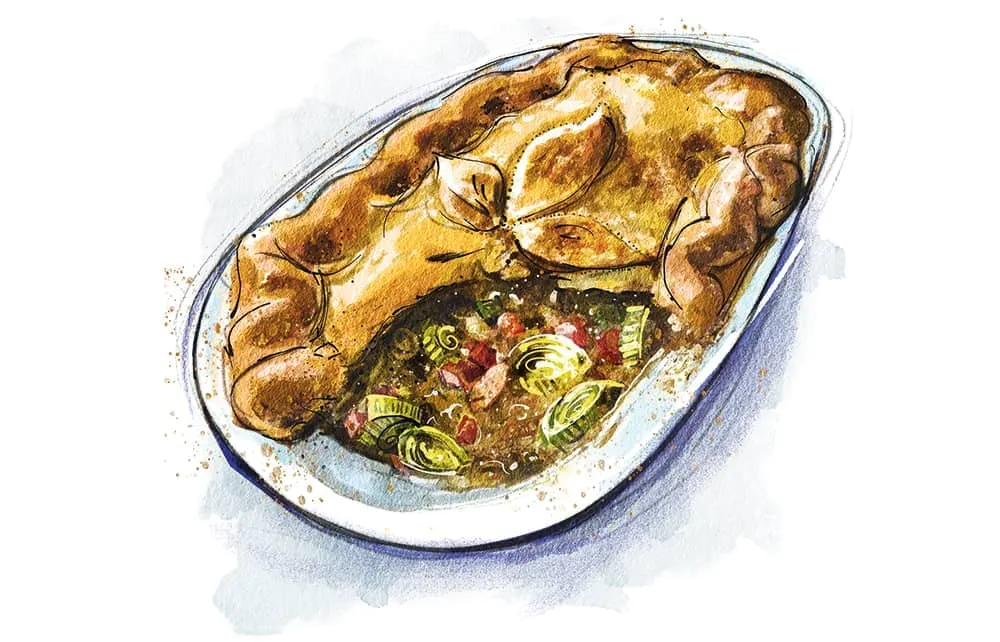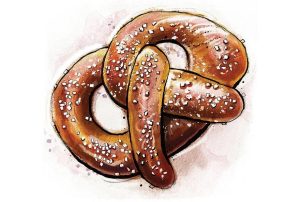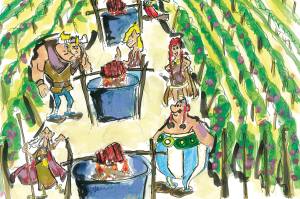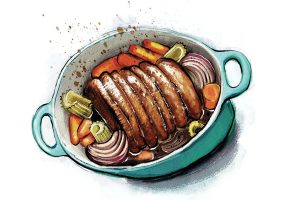Laurie Colwin wrote: “No one who cooks, cooks alone. Even at her most solitary, a cook in the kitchen is surrounded by generations of cooks past, the advice and menus of cooks present, the wisdom of cookbook writers.” It is one of my favorite quotes about cooking, mainly because it feels true: everything you cook is informed by other dishes, those that you’ve cooked, those that you’ve tasted or read about, the successes and the failures. In quiet moments of kitchen solitude, it is reassuring to know that there is an army of cooks behind me, each offering their experience, their recipes and books, a hand to hold when I feel uncertain.
I never feel the truth of Colwin’s words more than when I’m making a chicken pie. My chicken pie is an amalgamation of every chicken dish I’ve ever made. Inside that one pie is a debt of gratitude owed to all my favorite cooks and writers: a recipe by Anna Hedworth, proprietor of Newcastle’s Cook House, was my go-to chicken pie for years. It is so old that I can’t even find it any more. Diana Henry’s obsession with chicken thighs means that they are always the first joint I reach for. Kate Young’s chicken with tarragon (inspired by the dish in Anna Karenina) is such a simple but gorgeous dish that I now automatically throw a generous handful of the sweet herb into the sauce. The leeks that Nigella puts in her one-pot chicken and orzo turned me into a chicken-and-leek evangelist. Once I had tried Rosie Mackean’s method of retaining the skin and adding it to the filling, there was no going back.
This is, as is only right and proper in this column, an old-fashioned chicken pie: big chunks of meat, lots of soft, buttery leeks, smoky nuggets of bacon, all bound together with a roux-thickened sauce (a velouté, if we’re being fancy) woken up with white wine, and enriched with just a little cream at the end. The pastry is my ideal mixture of shortcrust and suet: where it touches the filling, the crust is soft, almost dumpling-like, taking on the flavor of the sauce, but on top it will be puffed and golden, and flake as the fork touches it. Suet is a lovely pastry to work with: soft and pliable, and easy to handle — but if you don’t have the time or inclination, shop-bought puff will act as a substitute.
Pie purists look away now, though: my pie has only a pastry lid, and no pastry bottom. If it’s not a circle of dry puff floating on top of a casserole, I think this is entirely permissible, and even makes for a better ratio of filling to pastry. But I know there are those who will disagree with me: if you are unmovable on the pie definition, double the pastry recipe, line the base of the pie dish and chill the filling before adding it.
Although I make this with skin-on, bone-in chicken thighs, you can of course use a whole roast chicken, or leftovers if you fancy. As a rule of thumb, you will need around a pound of picked, cooked meat. And if you’re going down this route, the carcass itself, slung into a pot with a carrot, an onion and some celery, and covered in water, will produce a brilliant homemade chicken stock for you to use too. During the festive period in my house, this pie becomes the base for a leftover turkey pie, often with everything but the Quality Street thrown in for good measure. When it’s available, I like to add a handful of wild garlic to the sauce in place of the tarragon. Whatever its finished form, this pie comes with culinary company and camaraderie. I hope that if you cook it — or an adapted version — then you too will feel less solitude in the kitchen.
For the pastry
- 9 oz self-raising flour
- 1 tsp fine salt
- 2 ⅔ oz butter, cold
- 2 ¾ oz suet
- 3 ½ fl oz cold water
- 1 tsp white wine vinegar
- 1 egg yolk, for glazing
For the filling
- 1 lb 5 oz bone-in, skin-on chicken thighs
- 3 ½ fl oz white wine
- 20 fl oz chicken stock
- 2 large leeks, cleaned and sliced into 1cm rounds
- 4 ½ oz pancetta
- 1 ½ oz plain flour
- 1 ¾ oz double cream
- 1 ½ oz butter
- 1 tbsp chopped tarragon
- Rub the butter into the flour and salt until it resembles breadcrumbs, then stir the suet through the mix. Add the vinegar and water and bring together first with a knife then, as the mix becomes less sticky, with your hands. Roll into a ball, cover with clingfilm, and leave to rest in the fridge for at least an hour
- Season the chicken thighs and lay them skin-side down in a cold pan. Bring the pan up to medium heat, and cook until the skin releases from the pan, and is golden brown — about fifteen minutes. Turn the thighs over, and deglaze the pan with the white wine. Add stock, bring to a simmer and cook for twenty minutes, then lift the thighs out and set to one side
- Put the lardons in a cold pan over a medium heat, and cook until crisp. Add the butter and leeks to the pan, and cook gently until soft, then stir the flour into the lardons and leeks, and cook for three minutes more. Add the stock, bit by bit, followed by the cream and then the tarragon. Taste and adjust seasoning accordingly
- Pull the cooked chicken flesh and skin. Combine with the sauce in a pie dish, cover with clingfilm touching the sauce directly, and leave to cool
- Preheat oven to 350°F. Once the filling is cold, roll out the pastry into a sheet about the thickness of a pound coin, and place over the pie filling, crimping at the sides. Brush with egg yolk, and bake for one hour. Leave to cool for ten minutes before serving
This article was originally published in The Spectator’s UK magazine. Subscribe to the World edition here.


















